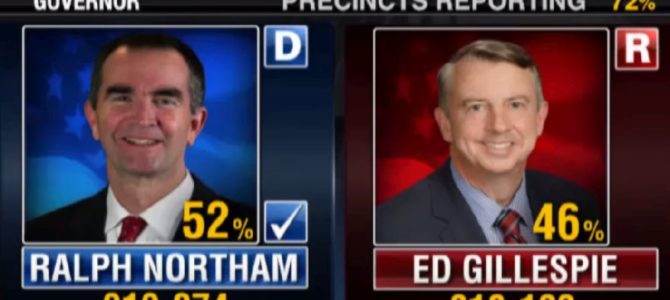
Virginia held elections for governor, lieutenant governor, attorney general, and delegates on Tuesday. Here are a few takeaways on what happened.
1) An Absolute Tidal Wave for Democrats
Democrats won all the top of the ballot races, but they also gained at least 13 seats in the House of Delegates. This was no small feat. Republicans previously held the House with 66 seats to Democrats’ 34. One of the switches includes the defeat of longtime conservative delegate Robert Marshall (R) by Danica Roem, whose claim to fame is transgenderism.
The gubernatorial race was the one that commanded most of the media interest, but a Democratic governor winning a pretty solid blue state is not the most shocking. The massive changes in the House of Delegates are another thing. The amount of effort that went into this is huge. Everything went Democrats’ way in the 2017 election in Virginia.
2) Top Of Ballot Republicans Lost, But In Interesting Ways
Ralph Northam beat Ed Gillespie in the governor’s race 53.9 to 45 percent — by nearly nine points. Justin Fairfax beat Jill Vogel in the lieutenant governor’s race 52.7 to 47.3. And Mark Herring beat John Adams 53.3 to 46.7 percent.
By comparison, Hillary Clinton won 52.8 percent of the two-party portion of the 2016 vote to Donald Trump’s 47.2 percent. Vogel and Adams were known as strong Trump supporters, whereas Gillespie was known as an establishment Republican who tried to embrace Trumpism without talking about Trump. Vogel and Adams performed state-wide roughly the same as Trump did, whereas Gillespie just got crushed. Gillespie only lost his 2014 Senate race to Warner by less than a percentage point.
What does it mean that Gillespie performed not just worse than Trump, and worse than he did in 2014, but worse than his top-of-the-ballot cohorts who were openly Trump-supportive? Many theories have been offered.
Some say his attempt at fusionism failed, and that you can’t be half a populist and expect voters to buy it. Others say he didn’t have the benefit of running against Clinton, a candidate who managed to lose nationwide despite having so many resources supporting her. Others say it’s just Gillespie himself — a seasoned swamp lobbyist and establishment figure running for office at a time when voters have had enough of that sort. But Gillespie performed quite well with downstate, traditional conservative Republican voters, failing to resonate in his own homeland of Northern Virginia. He only did a tiny bit better than Trump in the heart of the swamp — Fairfax County. That’s Gillespie’s home county!
No matter the cause, Gillespie didn’t do as well as Trump in a race where his running mate Vogel did slightly better than Trump had.
3) Democrats Are Finally Focusing on Statehouse Races
Democrats are finally focusing on statehouse races, and this should terrify Republicans. Democrats lost some 958 state legislative seats during the Obama administration. Those years saw a strong federal executive, but very little attention paid to Democrats at the state and local level.
The Washington Post had a story last week that suggested the huge win for Democrats in Virginia was no accident, but the result of a carefully crafted campaign being tested for nationwide rollout:
For a new crop of Democratic groups, Virginia is the opening salvo and a testing ground ahead of what they hope is a wave election in 2018.
Virginia is the first state to hold a competitive contest for governor after Trump moved into the White House, and both parties want to win it — the Democrats as a rebuke of Trump, and the Republicans to show they are not blemished by an unpopular president.
It’s also a purple state where Democrats have been winning statewide since 2009, but Republicans hold 66 of the 100 seats in the House of Delegates. Democrats are running in 54 GOP-held districts this year, and scores of groups — some well-financed, some loosely organized, are looking to leave their mark on those contests.
There’s a Democratic super PAC planning to spend $1 million — with an eye to a bigger goal of raising $100 million to take control of state houses across the country.
An organization founded by wealthy Virginia donors and bankrolled by a Silicon Valley entrepreneur is beta-testing technology to help low-budget campaigns run more efficiently.
Given the success this high-dollar, high-technology strategy yielded, expect to see many more resources applied in a state near you to achieve the same effect.
4) What Does It Mean For 2018?
If anyone tells you they know, you might check their punditry and prognostication track record for the last few years before taking their word. Republicans were elated when they won four special House elections, retaining Republican seats, in 2017. Some of them were in tight or difficult districts. That got them excited. Democrats have every reason to be elated by their stunning victory in Virginia, and a generally good election night last night.
It’s reasonable to surmise that 2018 is going to look more like 2006, a Democratic surge election, than 1994, a Republican surge election. Having said that, however, it’s still a year away and nobody knows at this point what that year holds.
5) Republicans Have to Start Delivering on Their Campaign Promises
If Gillespie had won his race for the governorship and the Republicans kept the House of Delegates despite the lack of progress by Republicans who control the congressional and executive branches, maybe there would be an argument for continuing in that vein. But with Democrats emboldened by their huge win in Virginia and a demoralized Republican base, members of Congress are delusional if they think they can keep their jobs without passing tax reform, repealing Obamacare, and some other dramatic achievement.
Republicans have to make the case for their survival.








